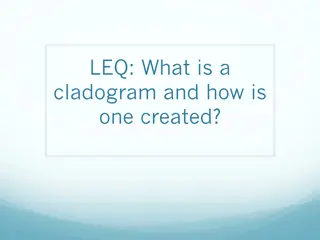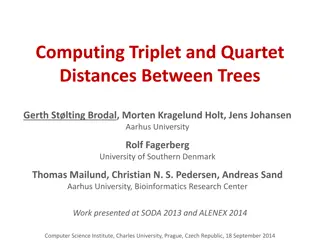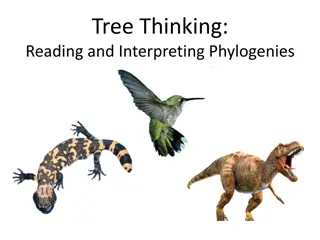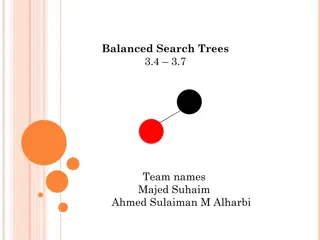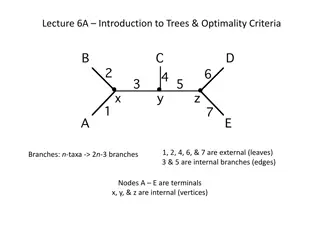Scalability of Computing Triplet and Quartet Distances in Phylogenetic Trees
Phylogenetic trees are widely used in various scientific disciplines, particularly in biology and bioinformatics. This study focuses on measuring the dissimilarity between trees using triplet and quartet distances. The research explores the computational challenges and strategies for comparing trees based on different leaf labels. Various algorithms and methodologies are discussed to efficiently calculate and analyze the differences in tree structures.
Download Presentation

Please find below an Image/Link to download the presentation.
The content on the website is provided AS IS for your information and personal use only. It may not be sold, licensed, or shared on other websites without obtaining consent from the author.If you encounter any issues during the download, it is possible that the publisher has removed the file from their server.
You are allowed to download the files provided on this website for personal or commercial use, subject to the condition that they are used lawfully. All files are the property of their respective owners.
The content on the website is provided AS IS for your information and personal use only. It may not be sold, licensed, or shared on other websites without obtaining consent from the author.
E N D
Presentation Transcript
On the Scalability of Computing Triplet and Quartet Distances Morten Kragelund Holt Jens Johansen Gerth St lting Brodal Aarhus University 1
Introduction Trees are used in many branches of science. Phylogenetic trees are especially used in biology and bioinformatics. We want to measure how different two such trees are. Athene Noctua Macropus Giganteus Oryctolagus Cuniculus Homo Sapiens Sus Scrofa Domesticus Equus Asinus Panthera Tigris Ursus Arctos Holt, Johansen, Brodal On the Scalability of Computing Triplet and Quartet Distances 2
Distances Natural in some cases. Between trees? ? Holt, Johansen, Brodal On the Scalability of Computing Triplet and Quartet Distances 3
Triplets and Quartets Triplets Used in rooted trees. Sub-trees consisting of three leaves. in a tree with n leaves. With 2,000 leaves, 1,331,334,000 triplets. Na ve algorithm runs in at least (n3). Number of disagreeing triplets. Quartets Used in unrooted trees. Sub-trees consisting of four leaves. in a tree with n leaves. With 2,000 leaves, 664,668,499,500 quartets. Na ve algorithm runs in at least (n4). Number of disagreeing quartets. Holt, Johansen, Brodal On the Scalability of Computing Triplet and Quartet Distances 4
Goal Comparison of two trees (T1and T2) with the same set of leaf-labels. Numerical value of the difference of the two trees. Number of different triplets (quartets) in the two input trees. A tree has a distance of 0 to itself. Holt, Johansen, Brodal On the Scalability of Computing Triplet and Quartet Distances 5
Brodal et al. [SODA13] Triplets Quartets For binary trees C, D and E are all zero Holt, Johansen, Brodal On the Scalability of Computing Triplet and Quartet Distances 6
Brodal et al. [SODA13] Binary Arbitrary degree Triplets O(n lg n) Up to 4d+2 counters in each HDT node Quartets O(n lg n) O(max(d1, d2) n lg n) 2d2+ 79d + 22 counters 2d2+ 79d + 22 counters A lot of counters . Is this even feasible? Why the d factor on arbitrary degree quartets? d2counters Holt, Johansen, Brodal On the Scalability of Computing Triplet and Quartet Distances 7
Overview Basic idea Each triplet (quartet) is anchored somewhere in T1. Run through T1, and for each triplet (quartet), check if they are anchored the same way in T2. The algorithm consists of four parts 1. Coloring 2. Counting 3. Hierarchical Decomposition Tree (HDT) 4. Extraction and contraction Holt, Johansen, Brodal On the Scalability of Computing Triplet and Quartet Distances 8
1. Coloring Consists of two steps 1. Leaf-linking 2. Recursive coloring O(n) O(n lg n) v Holt, Johansen, Brodal On the Scalability of Computing Triplet and Quartet Distances 9
2. Counting Using the coloring of T1and T2we count the number of similar triplets (quartets). Resolved Disagreeing No reason to look at all triplets (would be much too slow) Instead, look at inner nodes. In each inner node, we can keep track of the number of different triplets (quartets), rooted at the given node. Using counting and coloring, the triplet distance can be calculated in O(n2). Holt, Johansen, Brodal On the Scalability of Computing Triplet and Quartet Distances 10
3. Hierarchical Decomposition Tree (HDT) Problem: T2is unbalanced. Solution: Hierarchical Decomposition Trees. C C C HDT C C C C I G I G I G C C G G G G I G I G I G G G Triplet distance in O(n lg2n) Built in linear time Locally balanced Holt, Johansen, Brodal On the Scalability of Computing Triplet and Quartet Distances 11
4. Extraction and Contraction Ensuring that the HDT is small, we can cut off that lg n factor. If the HDT is too large, remove the irrelevant parts. Remove lg n factor O(n lg n) Holt, Johansen, Brodal On the Scalability of Computing Triplet and Quartet Distances 12
On input with more than 10,000 leaves Optimizations 1. [SODA13] hints at constructing HDTs early. Problem: HDTs take up a lot of memory. Solution: Postpone HDT construction. Result: 25-50% reduction in memory usage. 4-10% reduction in runtime. Utilizing the standard C++ vector data structure. Problem: Relatively slow (for our needs). Solution: A purpose-built linked list implementation. Result: 6-9% reduction in runtime on binary trees. Allocating memory whenever needed. Problem: (Relatively) slow to allocate memory. Solution: Allocation in large blocks. Result: 18-25% improvement in the runtime. 10-20% increase in memory usage on large input. 2. 3. 25% improvement in runtime 45% reduction in memory usage Holt, Johansen, Brodal On the Scalability of Computing Triplet and Quartet Distances 13
Limitations Two primary limitations in our implementation: Integer representation and are in the order of n3and n4. With signed 64-bit integers, quartet distance of only 55,000 leaves. Solution: Signed 128-bit integers for n4counters. Quartet distance of up to 2,000,000 leaves. Recursion depth OS imposed limitation in recursion stack depth. Input, consisting of a very long chain, will fail. Windows: Height ~4,000. Linux: Height ~48,000. Solution: Purpose built stack implementation*. *Not done in the implementation Holt, Johansen, Brodal On the Scalability of Computing Triplet and Quartet Distances 14
Results: [SODA13] It works, and it is fast! Leaves Time (s) 1,000 .29 10,000 3.90 100,000 42.60 1,000,000 N/A Holt, Johansen, Brodal On the Scalability of Computing Triplet and Quartet Distances 15
Improvements Why max (d1, d2)? d-counters given by first input tree [SODA13]: Calculates 6 out of 9 cases. [SODA13]: d1= 2, d2= 1024 is much slower than d1= d2= 2. min Add 5d2+ 18d + 7 counters x x x Total 7d2+ 97d + 29 counters Remove need for swapping O(min(d1, d2) n lg n) Holt, Johansen, Brodal On the Scalability of Computing Triplet and Quartet Distances 16
Results: Improved Faster in alle cases Leaves Time (s) 1,000 .02 10,000 .31 100,000 4.14 1,000,000 52.05 Holt, Johansen, Brodal On the Scalability of Computing Triplet and Quartet Distances 17
More improvements Triplets Quartets A+B is a choice Count A+E instead Faster? Holt, Johansen, Brodal On the Scalability of Computing Triplet and Quartet Distances 18
More improvements To count B 14 cases 92 sums 5d2+ 48d + 8 counters O(min(d1, d2) n lg n) To Count E 5 cases 21 sums 1d2+ 12d + 12 counters O(min(d1, d2) n lg n) Holt, Johansen, Brodal On the Scalability of Computing Triplet and Quartet Distances 19
Results: More improvements Fastest in the field Leaves Time (s) 1,000 .01 10,000 .21 100,000 3.07 1,000,000 40.06 Holt, Johansen, Brodal On the Scalability of Computing Triplet and Quartet Distances 20
Overview Binary Arbitrary degree d1 = d2 = 256 Triplets [SODA13]: O(n lg n) [SODA13]: ~34 seconds [SODA13]: O(n lg n) [SODA13]: ~7 seconds Quartets [SODA13]: O(n lg n) [SODA13]: O(max(d1, d2) n lg n) [ALENEX14]: O(min(d1, d2) n lg n) [SODA13]: ~125 seconds [SODA13]: ~139 seconds [ALENEX14] v1: ~112 seconds [ALENEX14] v1: ~83 seconds [ALENEX14] v2: ~45 seconds [ALENEX14] v2: ~62 seconds Balanced tree, 630.000 leaves Holt, Johansen, Brodal On the Scalability of Computing Triplet and Quartet Distances 21
Conclusion [SODA13] is both practical and implementable. We have Performed a thorough study of the alternative choices not studied in [SODA13]. Theoretically, and practically, found good choices for the parameters. Shown that [SODA13], and derivatives, successfully scales up to trees with millions of nodes. Open problem Current algorithm makes heavy use of random accesses, and doesn't scale to external memory. Current algorithm is single-threaded. Morten Kragelund Holt, Jens Johansen, Gerth St lting Brodal On the Scalability of Computing Triplet and Quartet Distances 22





